18世纪的英国文学ppt
- 格式:ppt
- 大小:1.34 MB
- 文档页数:27
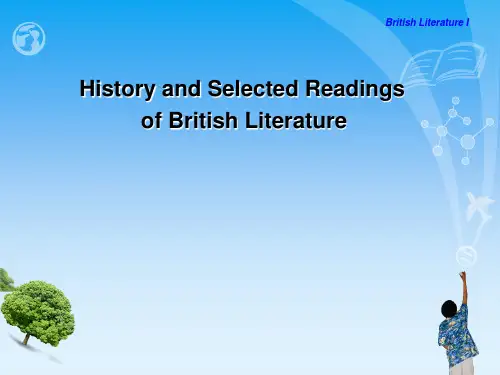


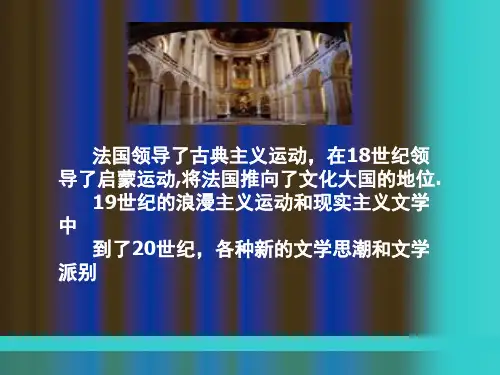
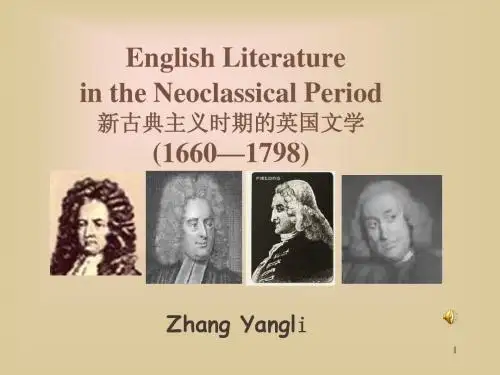
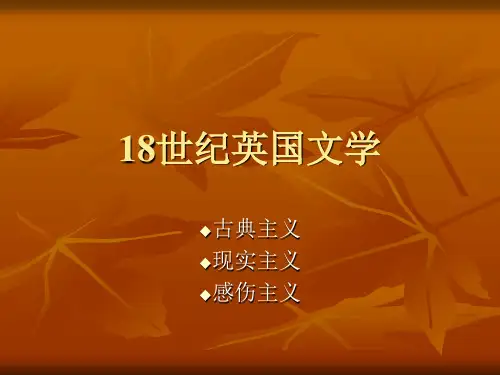
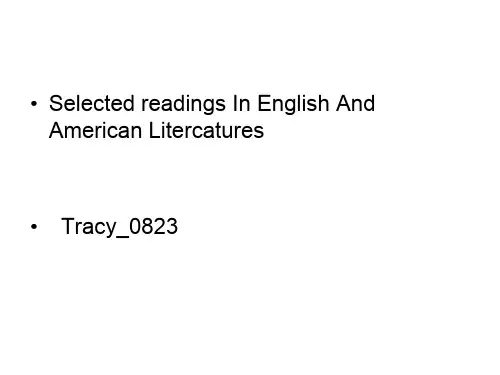
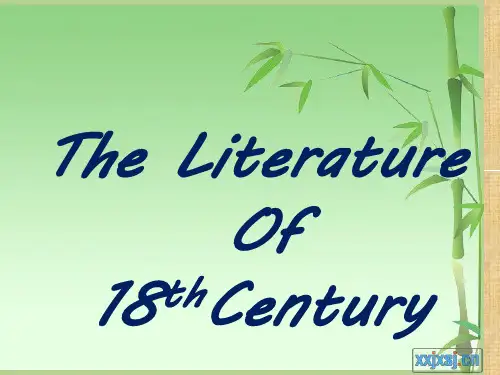
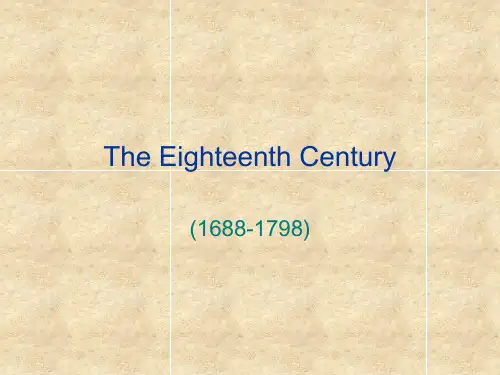
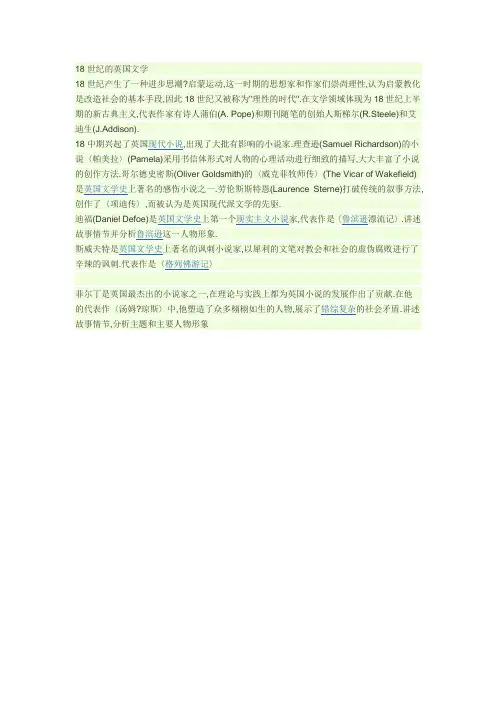
18世纪的英国文学
18世纪产生了一种进步思潮?启蒙运动,这一时期的思想家和作家们崇尚理性,认为启蒙教化是改造社会的基本手段,因此18世纪又被称为"理性的时代".在文学领域体现为18世纪上半期的新古典主义,代表作家有诗人蒲伯(A. Pope)和期刊随笔的创始人斯梯尔(R.Steele)和艾迪生(J.Addison).
18中期兴起了英国现代小说,出现了大批有影响的小说家.理查逊(Samuel Richardson)的小说〈帕美拉〉(Pamela)采用书信体形式对人物的心理活动进行细致的描写,大大丰富了小说的创作方法.哥尔德史密斯(Oliver Goldsmith)的〈威克菲牧师传〉(The Vicar of Wakefield)是英国文学史上著名的感伤小说之一.劳伦斯斯特恩(Laurence Sterne)打破传统的叙事方法,创作了〈项迪传〉,而被认为是英国现代派文学的先驱.
迪福(Daniel Defoe)是英国文学史上第一个现实主义小说家,代表作是〈鲁滨逊漂流记〉.讲述故事情节并分析鲁滨逊这一人物形象.
斯威夫特是英国文学史上著名的讽刺小说家,以犀利的文笔对教会和社会的虚伪腐败进行了辛辣的讽刺.代表作是〈格列佛游记〉
菲尔丁是英国最杰出的小说家之一,在理论与实践上都为英国小说的发展作出了贡献.在他
的代表作〈汤姆?琼斯〉中,他塑造了众多栩栩如生的人物,展示了错综复杂的社会矛盾.讲述故事情节,分析主题和主要人物形象。

English Literature in the 18th Century (the Age of Enlightenment or the Age ofReason)BackgroundSome Important TermsThree Stages in the EnlightenmentPolitically➢Glorious Revolution in 1688 ended the monarchy, replacing it with a constitutional monarchy.➢The power passed from the king gradually to the parliament.➢the Tory and the Whig dominated the parliament by turnsSocially⏹the rapid growth of middle class⏹The Puritan spirit of wisdom, diligence, honesty, and thriftiness, self-discipline ⏹better education was available⏹more schools and social clubs were establishedEconomically◆Industrial Revolution, the 1st powerful industrial country◆continued to expand its coloniesIdeologicallyUnder the influence of scientific discoveries( Galileo,Newton) and flourishing of philosophies, French enlightenment started.Some Important Terms Enlightment:an intellectual movement beginning in France and then spread throughout Europe.•a continuation of Renaissance in belief in the possibility of human perfection through education•the guiding principle or slogan isRation/Reason, natural right and equality •Ration became standard for measurement of everything.Some Important Terms Neoclassicism: Appeared in last decades of the 17th to the early of the18th•Modelled Greek and Latin authors •Stress on order, logic, proportion, restrained emotion, accuracy, good taste major exponents of the neoclassical school: John Dryden and Alexander Pope.Sentimentalism:One of the important trends in English literature of the middle and later decades of the 18th century.•A new vision of love, a new view of human nature : prized feeling over thinking, passion over reason, personal instincts of "pity, tenderness, and benevolence" over social duties. •Representives:Edward Young and Thomas Gray (poetry) Laurence Sterne and Oliver Goldsmith (prose fiction )Gothic Novel•against the rationalism and commercialism •emphasis on the irrational and dark side of human nature; the imaginative, the supernatural, the discarded Medieval castle •Representative:Horace Walpole--The Castle of OtrantoSome Important TermsPre-Romanticism:•It was marked by a strong protest against the bondage of classicism, by a recognition of the claims of passion & emotion, and by a renewed interest in medieval literature.•Rrpresentatives:William Blake & Robert Burns(poetry)The First Stage•Lasted from the “Glorious Revolution”to the end of the 1730’s.•Characterized by the so-called neoclassicism in poetry(the representative poet:Alexander Pope)•A new prose literature appeared in the essays of Joseph Addison and Richard Steele and in the first realistic fiction of Daniel Defoe and Jonathan Swift.Alexander Pope •Alexander Pope(1688-1744)•An English essayist,critic, satirist,and one of thegreatest poets of Enlightenment.Works•An Essay On Criticism, 1711 •The Rape Of The Lock, 1712-14 •Dunciad, 1728 -Widened in 1742 •An Essay On Man, 1733-34Translations:•Homer's Iliad, 1715-20•Homer's Odyssey, 1726Literary Style •Alexander Pope was best known for his satirical verse.He is famous for his use of the heroic couplet.•Heroic Couplet is a traditional form for English poetry ; commonly used for epic and narrative poetry. it refers to poems constructed form a sequence of rhyming pairs of iambic pentameter lines .The rhyme is always masculine.Alexander Pope’s famous quotations •For fools rush in where angels fear to tread.•To err is human, to forgive, divine.• A little learning is a dangerous thing.Richard Steele(1672-1729)Joseph Addison(1672-1719)•Their literary activities:They jointly ran two newspapers:the Tatler(from 12 Apr.1709 to 2 Jan. 1711) the Spectators(from 1 Mar.1711 to 6 Dec. 1712),Published essays dealing with manners, morals and literature.•Their importance:Their essays truthfully portrayed the social life of England and paved the way for the coming of the English novel.Daniel Defoe(1660-1731)➢The Father of the English fiction •Personal Life:•1701: The True-born Englishman •1703:The Shortest Way with the Dissenters •1704: The Review a political and literary magazine in prison.•1719: Robinson Crusoe•1731: his deathWorks •Robinson Crusoe(masterpiece)•Captain Singleton•Moll Flanders•A Journal of the Plague Year •RoxanaFeatures of Daniel Defoe's Novels •1.Central idea : man is good and noble by nature but may succumb to an evil social environment. Society is the source of various crimes and vices.•2. Daniel Defoe deliberately avoided all arts, all fine writings, so that the readers could concentrate only on a series of plausible events. •3. Taking the form of memories or pretended historical narrative, everything in them giving the impression of reality.Jonathan Swift•His life(1667-1745)•Born in Ireland of an English couple.•His education: Studied at Trinity college , at Dublin University•After graduation:•Sir William Temple (private secretary, ten years).•Worked in a little church in Ireland•His death: brain diseaseWorks•Bickerstaff Almanac•The Battle of the Books •The Tale of A Tub•The Journal to Stella•The Drapier’s Letters •Gulliver’s TravelsGulliver’s Travels•Four books: four voyages of Gulliver •The first part: his shipwreck in Lilliput •The second part: Gulliver’s adventure •in Brobdingnag•The third part: Gulliver continues his adventures in Laputa•The four part:Gulliver came to a place where inhabitants are those wise horsesSwift’s Style •Jonathan Swift is one of the realist writers•His language is simple, clear and vigorous.•“Proper words in proper places, makes the true definition of a style”•Swift is a master satirist and his irony is deadly.The Second Stage •Lasted from 1740s to 1750s.•The more important works : the novels of Samuel Richardson, Henry Feilding and Tobias Smollett.•The last two writers make rather fierce attacks on the existing social conditions.Samuel Richardson•His life(1689-1761)•His works:•Pamela(Pamela Andrews, Mr. B the first English Psycho-Analytical novel)•Clarissa Harlowe(1747-1748)•Sir Charles GrandisonHenry Fielding•Father of the English Novel•He was the greatest playwright in his own time.•He is generally regarded as the greatest novelist of the 18th century.•The first to write specifically a “comic epic inprose”),whose subject is“the true ridiculou s”in human nature.Works•The History of the Adventures of Joseph Andrew•The Life of Mr Jonathan Wild, the Great •Amelia•The History of Tom Jones, a Foundling •Don Quixote in England•1. Fielding starts “the third-person narration”, that is told directly by the author, an omniscient narrator.•2. Satire abounds everywhere in his novels. There are two kinds of satire. One is the humorous satire, which is meant to be instructive and corrective. The other kind is grim satire, which is used to lash the cardinal evils of the corrupt ruling class.•3.Fielding believes in the educational function of the novel.•4. Fielding is a master of style. His style is easy, unlabored and familiar, bit extremely vivid and vigorous.•5.His novels are noted for individual dramatic dialogues, and other theatrical devices such suspense, coincidence and surprise.Tobias Smollett•Tobias George Smollett (19 March 1721 –17 September 1771)•A Scottish poet and author. He was best known for his picaresque novels(流浪汉小说), such as The Adventures of Roderick Random (1748) and The Adventures of Peregrine Pickle(1751), which influenced later novelists such as Charles Dickens.The Third Stage •Covered the last decades of the 18th century. •Characterized by the appearance of new literary tendencies of Sentimentalism and Pre-romanticism.Sentimentalism:Edward Young and Thomas Gray (poetry) Laurence Sterne and Oliver GoldsmithPre-romanticism:William Blake & Robert Burns(poetry)•Realistic dramatist: Richard B. SheridanEdward Young •Edward Young (1683 –April 5, 1765) was an English poet, best remembered for Night Thoughts.•Night Thoughts is noted for its psychological probings and its mixing of personal sentiments with religious deliberations.•Significance: It helped, in its small way, to move poetry forward toward the age of Romanticism.Sentimentalism:Laurence Sterne(1713-1768)•He is the forefather of the sentimentalism novel.•As a novelist, he was conscious and original, and contributed a good deal toward perfecting the art of genre in its early phase.•He was an iconoclast, an innovator, a trail-blazer, and an eternal presence in literary history.Works and Fictions' features •The Life and Opinions of Tristram Shandy,GentlemanA Sentimental Journey through France and Italy by Mr. Yorick.•Features: grotesque goodness, sweet humility, sensitive humanity, boisterous humor and idiosyncratic discursiveness.Sentimentalism:Oliver Goldsmith•General Comments•A man sometimes blundering and ridiculous, but tender-hearted,simple and generous• A versatile writer as a poet, novelist, dramatist, essayist•One of the representatives of English sentimentalism•Social justice and compassion for the poorWorks•The Vicar of Wakefield(1762)(a sengtimental novel)•The Citizens of the World(1762 )•The Traveller(1764)•The Good-Natured Man(1768)•The Deserted Village(1770 ) (a poem of sentimentalism)•She Stoops to Conquer(1773 0Writing style •Alternately praises, satirizes, and sentimentalizes a pioneer settlement •His novel appeals to human sentiment as a means of achieving happiness and social justice •Show passive resistance to social evilPre-romanticism:William Blake•A poet and an engraver• a Pre-Romantic Poet or the forerunner of the romantic poetsMajor worksPoetical SketchesSongs of ExperienceSongs of InnocenceMarriage of Heaven and HellWriting style•Plain and direct language.•Lyric beauty with immense compression of meaning.•Embody the views with visual images.•Symbolism in wide range.eg.To see a world in a grain of sandAnd a heaven in a wild flowerHold infinity in the palm of your handAnd eternity in an hourRichard B. Sheridan(Dramatist)•Sheridan, Richard Brinsley (1751-1816), •British dramatist and politician, whose work is considered the finest development of the comedy of manners(风尚喜剧) in 18th-century England.•Works:The Rivals,The School for Scandal and The CriticWriting Style•1. His dramatic techniques are largely conventional.•2. His plots are well organized, his characters, either major or minor, are all sharply drawn, and his manipulationof such devices as disguise, mistaken identity and dramatic irony is masterly.•3. Witty dialogues and neat and decent language also make a characteristic of his plays.Samuel Johnson •Samuel Johnson (18 September 1709 [O.S.7 September] –13 December 1784), often referred to as Dr Johnson, was an English author who made lasting contributions to English literature as a poet, essayist, moralist, literary critic, biographer, editor and lexicographer.•Johnson was a devout Anglican and committed Tory,and has been described as "arguably the most distinguished man of letters in English history".•He is also the subject of "the most famous single work of biographical art in the whole of literature"A Dictionary of the English Language•Johnson began to wrotethe dictionary from 1747,and it took him 7 years tofinish it.Though it was widelypraised and had a hugeimpact, Johnson didn’tgain much money fromit.Other works•The Idler, a weekly series, ran from 1758 to 1760.•Proposals for Printing, by Subscription, the Dramatick Works of William Shakespeare, in 1756, which argued that previous editions of Shakespeare were edited incorrectly and needed to be corrected•Rasselas, a philosophical novella, on 19 April 1759.•The Plays of William Shakespeare, in Eight Volumes... To which are added Notes by Sam. Johnson,10 October 1765 •Lives of the English Poets, in 1777Thank You !。
I . Historical BackgroundWith the Glorious Revolution, England became a constitutional monarchy and, the state power passed from the king gradually to the Parliament and the cabinet ministers. Abroad, a vast expansion of British colonies in Asia, Africa and North America, and a continuous increase of colonial wealth and trade provided England with a market for which the small-scale, manual production methods of the home industry were hardly adequate. All these created not only a great demand for large quantities of manufactured goods but also standardized goods made in Britain. This was the basic cause of the Industrial Revolution, of the invention of textile machines and other kinds of machinery.At home in the country, Acts of Enclosure were putting more lands into the hands of fewer privileged rich landowners and forcing thousands of small farmers and tenants off their land to become wage earners in industrial towns. As a result, there appeared a market of free labor anal free capital, thus providing the essential conditions for the rising of Industrial Revolution. So, towards the middle of the 19th century, England had become the first powerful capitalist country, the work-shop of the world, flooding the markets both at home and abroad with itsmanufactured goods.These changes, both political and social, enriched the bourgeoisie and the aristocracy who ruled the country, but brought great miseries to the majority of the people in England, Scotland, and Ireland; and in the colonies. Popular uprisings again and again hit Ireland; in Scotland people were threatening of independence from the British government; and the American people started their War of Independence in 1776 and finally broke away from the British government.As England was growing into a powerful industrial country, it also witnessed the rapid growth of the bourgeois middle class at home. These- were mainly city people: traders, merchants, manufacturers, and other adventurers such as slave-traders and colonists. They became the backbone of the fast developing England. As the Industrial Revolution went on in its full swing, more and more people joined the rank of the middle class. It was a revolutionary class then and quite different from the feudal-aristocratic class. They were the people who had known poverty and hardship, and most of them had obtained their present social status through much hard work. Morally, they stressed the virtues of self-discipline, thrift and hard work. For them, to work and to accumulate wealth constituted the wholemeaning of their life.Ⅱ. Cultural Background1. EnlightenmentThe Enlightenment was a progressive intellectual movement throughout Western Europe in the 18th century. It was an expression of struggle of the bourgeoisie against feudalism. The enlighteners fought against class inequality, stagnation, prejudices and other survivals of feudalism. They thought the chief means for bettering the society was "enlightenment" or "education" for the people. The English enlighteners were bourgeois democratic thinkers. They were different from those of France, for they appeared not before but after the bourgeois revolution. They set no revolutionary aim before them and what they strove for was to carry the revolution through to an end.Most of the English writers were enlighteners. They fell into two groups-the moderate group and the radical group. The more moderate enlighteners supported the principles of the existing social order and considered that partial reforms would be sufficient. In this group may be included chiefly Alexander Pope, Joseph Addison and Richard Steele, Daniel Defoe andSamuel Richardson.The more radical enlighteners struggled for more resolute democratization in the management of the government, and defended the interests of the exploited masses, the peasants and the working people in the cities. The representative writers of this group are Jonathan Swift, Henry Fielding, Tobias George Smollett, Oliver Goldsmith and Richard Brinsley Sheridan.Most of the writers of the moderate group acknowledged that the existing social system of the day was essentially fair and just. On this basis they tried to work out a standard of moral conduct, which could be more suitable to the existing social conditions while the writers of the radical group stressed the discrepancy between what they called "the proper moral standards" and the bourgeois-aristocratic society of their age.2. Cultural ProgressInspired by the spirit of the Enlightenment, people were encouraged to cultivate a sense of rationality and a witty intellectuality. More schools were set up throughout the country so as to provide a better education for the masses. As more people had now more money and more leisure time, and became better educated, a widely distributed reading public grew,especially among the well-to-do middle class women. This demanded more reading materials which would be of interest and satisfy their need for a rational and moral life. Outside regular schools, literary works of all kinds played a decisive role in popularization of general education. The Copyright Act of 1709 made, for the first time in English history, literary creation an honorable and independent profession. Writers like Alexander Pope were able to live a life independent of those rich aristocratic patrons. Along with the economic independence, the eighteenth-century writers enjoyed greater freedom in their creative activities and were now able to devote themselves to whatever interested them and to give utterance to whatever they thought right or proper. For the first time too, the literary tendency of the age was moving-away from the conventional romance stories about the life of the rich and noble people of the aristocratic class and turning to works that would give accounts of the common life of the ordinary folk.Besides the popular forms of poetry, novel and drama, the period also saw the appearance of such popular press as pamphlets and newspapers and periodicals which served as the party mouth-organs as well as an ideal medium for public education. And there was also the flourish of coffee houses andall kinds of social clubs, (about 2000 in London.) which greatly helped the cultivation and promotion of the new English culture.However, in the later part of the century, people began to feel discontented with the rigidity of rationality. A demand for a release of one's spontaneous feeling, a relaxation from the cold and rigid logic of rationality and an escape from, the inhuman Industrial Revolution gradually took shape in the form of sentimental novel and poetry.Ⅲ. Characteristics of the Literature1. A General ViewThe main literary stream of the 18th century was realism. What the writers described in their works were social realities. The main characters were usually common men. Most of the writers concentrated their attention on daily life. In this century the newspaper was born. Literature, which included the book, the newspaper and the magazine, became the chief instrument of the nation's progress. The new social and political conditions demanded expressions not simply in books but more especially in pamphlets, magazines and newspapers. Poetry, which had been the glory of English literature in the preceding ages, was inadequate for such a task. So prose had a rapid development in this age. The 18th century was an age of prose. A group ofexcellent prose writers, such as Addison, Steele, Swift, Fielding, were produced.Novel writing made a big advance in this century. The main characters in the novels were no longer kings and nobles but the common people.In this age satire was much used in writing. It refers to any writing, in poetry or prose, with the purpose to ridicule follies, stupidities,the vices and corruptions of the society, which threatened to be contrary to the maintenance of good moral order and literary discipline. So, it answered well the purpose of the Enlightenment, which aimed at public education in moral, social as well as cultural life. It also proved to be an effective weapon for arguments of all kinds and verbal attacks on enemies of both the parties and the personal. Since there was fierce strife of the two political parties in society, nearly every writer of this century was employed and rewarded by Whigs or Tories for satirizing their enemies. English literature of this age produced some excellent satirists, such as Pope, Swift and Fielding. So, it became the fashion for all forms of writing at the time.The development of the literature in this period can be summarized as: the predominance of neoclassical poetry and prose in the early decades of the 18th century; the rise andflourish of modern realistic novel in the middle years of the 18th century; and the appearance of the sentimental and pre-romantic poetry and fiction in the last few decades of the 18th century.2. Neo-Classicism in English LiteratureNeo-Classicism made a rapid growth and prevailed for the better part of the 18th century. In early 18th century, writers of the neo-classical school were Addison, Steele and Pope. In the middle decades of the century, Samuel Johnson became the leader of the classical school in English poetry and prose.This term mainly applies to the classical tendency which dominated the literature of the early period. It found its artistic models in the classical literature of the ancient Greek and Roman writers, and tried to control literary creation by some fixed laws and rules drawn from their works, for example, rimed couplet instead of blank verse and the three unities of time, place and action,etc. It put the stress on the classical ideals of order, logic, restrained emotion, accuracy, good taste .The English classicists followed these standards in their writings. They tried to make English literature conform to rules and principles established by the great Roman and Greek classical writers. Prose should be precise, direct and flexible. Allthe neo-classicists followed these standards in writing.Alexander Pope (1688-1744)Pope was the representative writer of the neo-classical school. In the field of satiric and didactic verse, he was the undisputed master. His influence completely dominated the poetry of his age. Many foreign writers and the majority of English poets looked to him as their model. His poetry clearly reflected the spirit of the age in which he lived. Pope was a master in satire and heroic couplet. He popularized the neo-classical literary tradition. He was one of the early representatives of the Enlightenment, who introduced into English culture the spirit of rationalism and greater interest in the human world. He represented the highest glory and authority in matters of literary art and made great contributions to the theory and practice of prosody诗学.Pope's Major WorksAn Essay on Criticism, written in heroic couplet, consisting of 744 lines and divided into three parts, was a manifesto of English neo-classicism as Pope put forward his aesthetic theories in it. Pope’s Essay on Criticism was a comprehensive study of theories of literary criticism.Essay on Man, written in heroic couplet, indicates the poet's political and philosophical viewpoint. It deals with man' srelation to the universe, to society, to himself, and to happiness. The Dunciad is Pope' s famous satirical poem. It is full of bitter personal attacks on the poet's personal enemies, and it also gives a broad satirical picture of the whole literary life in the early 18th century England.“A little learning is a dangerous thing.”“Short views we take, nor see the lengths behind.”“Hills peep over hills, and Alps on Alps arise!”Joseph Addison (1672-1719) and Richard Steele (1672-1729) In 1709 Steele started a literary periodical named “The Tatler”. In 1711, Addison collaborated with Steele to create a literary periodical called “The Spectator”."The Tatler" was published three times a week. It became widely read in London, especially in clubs and coffeehouses. The paper became extremely popular because it was just the sort of thing that suited the needs of the reading public among the bourgeoisie. "The Spectator", a daily paper, was a collaborative project by Addison and Steele together. It was much more important than "The Tatler" because it dealt with a wide range of subjects and was written in a maturer style. It offered the models of social and moral behaviour to the new British middle class besides discussing the current affairs and culture issues. Moreover Addison’s prose which is very clear, plain, fluent and elegant became a model for the writers of that time. His style is rich in humor and common sense, which is also imitated by other weiters and exerts a great influence abroad.The most striking features of the paper are the character sketches of Mr. Spectator and the members of his club,and these sketches become the forerunner of the modern Englishnovel.The essays in this periodical had a moral purpose.They attempted to improve manners and morals, and continued to struggle against the ideas of the aristocracy.Steele and Addison’s Contributions to English Literature1) Their writings in “The Tatler” and“The Spectator" provide anew code of social morality for the rising bourgeoisie.2) They give a true picture of the social life of England in the 18th century.3) In their hands, the English essay completely established itself as a literary genre.Using it as a form of character sketching and story-telling, they ushered in the dawn of the modern novel.3. English Realistic NovelsThe rise and growth of the realistic novel is the most prominent achievement in the 18th century English literature. The novelists of this group told the reader in their novels, not about knights or kings but about the ordinary people; about their thoughts; feelings and struggles. The major realist novelists of this century are Daniel Defoe, Jonathan Swift, Henry Fielding and Tobias George Smollett.The early literature in the Medieval or Renaissance period, only served the feudal aristocratic class. Almost all the literary works were about kings, queens, princes, feudal lords and their way of life. Even Shakespeare's plays were dominated by these people. Romance was the typical literary form which was to delight and entertain the aristocrats. But now, after the bourgeois revolution, the English middle-class people were ready to cast away the aristocratic literature of feudalism and to create a new kind of realistic literature of their own to express their ideas and serve their interests. Thus instead of the life of kings and feudal lords, the whole life in its ordinary aspects of the middle class became a major source of interest in English literature. This change of subject matter was most obvious in the new literary form of English realistic novel. Defoe, Richardson, Fielding,Sterne, Goldsmith and Smollett were among the major novelists of the time. They achieved in their works both realism and moral teaching. The influence of their works was very great both at home and abroad. It found impact in some of the great works of European writers and paved the way for the great nineteenth-century realistic writers like Jane Austen, Walter Scott, Charles Dickens and William Thackeray.“The novel is the most important gift of bourgeois, or capitalist, civilization to the world’s imaginative culture.” (Ralph Fox)Daniel Defoe: “Robinson Crusoe”—one of the forerunners of English realistic novelFielding: the real founder of realistic novelF.G. Smollet: his satirical novels touched upon various aspects of English life.Samuel Richardson: “Pamela” psychological an alysis Jonathan Swift: Swift is one of the greatest masters of satire.Daniel Defoe (1660-1731)Defoe was a journalist, a pamphleteer, a poet, and above all these, he was a novelist. He has been regarded as the discoverer of the modern novel.Robinson CrusoeAt the head of Defoe' s works stands his most important work The Life and Strange Surprising Adventures of Robinson Crusoe. It has held its popularity for more than two centuries.The story was based upon the experiences of a Scotch sailor called Alexander Selkirk, who had been marooned on a desert island off the coast of Chile and lived there in solitude for four or five years. After his return to Europe in 1709, his experiences became known. Defoe got inspiration from this real story and with many incidents of his own imagination, he successfully produced the famous novel Robinson Crusoe.The story is told in the first person singular as if it was told by some sailor-adventurer himself. In this novel, Defoe created the image of a colonizer and a foreign trader, who has the courage and will to face hardships, and who has determination to preserve himself and improve his livelihood by struggling against nature. Crusoe represents the English bourgeoisie at the earlier stage of its development. Being a bourgeois writer, Defoeglorifies the hero and defends the policy of colonialism of British government.Features of Defoe's NovelsA. Defoe is remembered chiefly for his novels. The central idea of his novels is that man is good and noble by nature but may succumb to an evil social environment. The writer wants to make it clear that society is the source of various crimes and vices.B. Defos' s intention is that the readers should regard his novels as real stories. For that reason, he deliberately avoids all art, all fine writing, so that the reader should concentrate only on a series of plausible events. Defoe's novels all take the form of memoirs, but everything in them gives the impression of reality.Jonathan Swift (1667-1745)Swift was born in Dublin.The Battle of the Books, and A Tale of a Tub. The former is a satirical dialogue on the comparative merits of ancient and modern writers. The writer influenced by classicism in the literature of the time thought the ancient writers were better than the modern ones. The latter is a prose satire and a sharp attack on the disputes among the different sects of the Christian religion.Among the pamphlets he wrote about Ireland, the best-known pieces are The Drapier' s Letters and A Modest Proposal. The Drapier's Letters were written of the actual social struggle against the debasement of the Irish coin. In the fourth letter, Swift speaks again and again of liberty and slavery in connection with the Irish people. In A Modest Proposal, Swift, with bitter irony, suggests that the poor Irish peasants fatten their one-year-old children and then sell them as food to the rich. This proposal is a most powerful blow at the English government's policy of oppression and exploitation in Ireland. Gulliver' s TravelsThe book contains four parts, each of them deals with one particular voyage of the hero and his extraordinary adventureson some remote island.In the first part, Gulliver goes to sea as a ship's surgeon. In a big storm the ship is wrecked and he is cast upon the shore of the island of Lilliput. The first part is full of references to current politics. Lilliput is the miniature of England. Swift's satire is directed against the English ruling class, the two political parties and the religious disputes.In the second part, Gulliver again goes to sea and his ship is again wrecked in a storm. Gulliver is abandoned on the land of the Brobdingnagians. The Brobdingnagians prove to be superior to the men and women of Gulliver's society in wisdom and humanity as well as in stature. Compared with them, he is very small, insignificant, mean and unworthy. In this part, the King of Brobdingnag is described as a wise and kind king, and the inhabitants are said to be a civilized race. The law of the country is used to defend the natives' freedom and happiness.The third part, which is often considered to be the least interesting, deals with a series of the hero's adventures at several places. The first place that Gulliver gets to is the floating island of Laputa. Gulliver finds out here the king and the noble persons are a group of absent-minded philosophers and astronomers who care for nothing but mathematics and music and who speakalways in mathematical terms of lines and circles. They often do useless research work, for example a scientist makes researches on how to get sunlight from cucumbers. Another scientist is studying how to construct a house by first building the room and then laying the base. Through these descriptions, Swift satirizes the scientists who keep themselves aloof from practical life.In the country of Laputa, the king and his ministers use cruel methods to suppress any rebellion of the people living on the continent below. Whenever the people rise up against them, they make the flying island hover over the place of the rebellion, thus preventing sunlight and rain from reaching it, or let the island drop directly upon the heads of the rebellion people. Here Swift condemns the cruelty of the ruling class to the people.Then Gulliver comes to the island of Sorcerers. This part contains Swift' s sharp satire against all kinds of English social institutions. While condemning the English ruling class, Swift praises the English people, thinking they are honest, brave, and have true love for freedom.The fourth part describes the hero's voyage to the country of the Houyhnhnms and has generally been considered the best part of the book because the satire here is the sharpest and the bitterest.In this part Gulliver is cast upon the shore of the land of the Houyhnhnms, who are horses endowed with reason, and who are the governing class. In this country there is a species of wild animals called Yahoos. The horses are extremely intelligent and noble, and possess all good qualities, while the Yahoos, though in many ways they are like human beings, are low and vile and despicable and no better than beasts. Gulliver praises the life and virtues of the horses and feels disgusted at the Yahoos. When Gulliver returns homes he can't stand the human life there. To him all his countrymen are the hateful Yahoos. This part does not show Swift's hatred and disgust for all the humanity. It just shows he dislikes those people who bring evils and inhuman life modes to human society. He cherishes a great love for the common people.Swift's Writing FeaturesA. Swift is one of the realist writers. His realism is quite different from Defoe's. Defoe's stories are based upon the reality of human life, while all of Swift's plots come from imagination, which is the chief means he uses in his satires.' His satire is very powerful. He not only criticizes the evils of the English bourgeoisie but those of other bourgeois countries.B. Swift expresses democratic ideas in his works. This exerts strong influence on later writers, such as Sheridan, Fielding, Byron and even Bernard Shaw.C. Swift is one of the greatest masters of English prose. His language is simple, clear and vigorous. He said, "Proper words in proper place, makes the true definition of a style.” There are no ornaments in his writings. In simple, direct and precise prose, Swift is almost unsurpassed in English literature.5. SentimentalismIn the first half of the 18th century, Pope was the leader of English Literature and heroic couplet the fashion of poetry. By the middle of the 18th century, sentimentalism came into being as the result of a bitter discontent among the enlightened people with social reality. The representatives of this school continued to struggle against feudalism, but they, at the same time, sensed the contradictions in the process of capitalist development. It was a direct reaction against the cold, hard commercialism which had dominated people’s life since the last decades of the 17th century. Besides, it seemed to have appeared hand in hand with the rise of realistic English novel.Dissatisfied with reason, sentimentalists appealed to sentiment, to “the human heart”. Sentimentalism turned to countryside for its material, and their writings were marked by a sincere sympathy for the peasants. It indulged in emotion and sentiment, which were used as a kind of mild protest against the social injustice. They thought the bourgeois society was founded on the principle of reason, so they began to react against anything rational and to advocate that sentiment should take the place of reason.In English poetry of the 18th century, sentimentalism first found its full expression in the forties and the fifties, in Thomas Gray's Elegy Written in a Country Churchyard. In the later decades of the century, it was found in a number of poems by William Cowper.In the field of prose fiction of the 18th century, sentimentalism had its most outstanding expression. There were three novelists who followed this tradition in novel writing. They are Samuel Richardson, Oliver Goldsmith and Laurence Sterne. It was first found in “Pamela”, an early English realistic novel by Richardson. Some famous novels of this kind are Laurence Sterne’s “A sentimental journey through France and Italy” and goldsmith’s “The Vicar of Wakefield”.6. Pre-romanticismWhile the classical literature prospered, a new Romantic movement quietly showed its appearance in English poetry. It was marked by a strong protest against the bondage of Classicism, by a renewed interest in medieval literature. In England, this movement showed itself in the trend of Pre-romanticism in poetry. It was represented by William Blake and Robert Burns. They struggled against the neoclassicaltradition of poetry. The chimney sweeper。